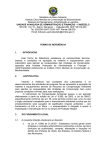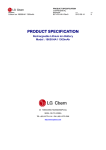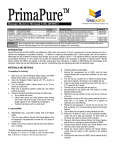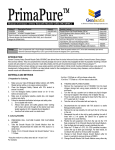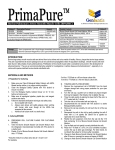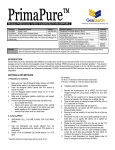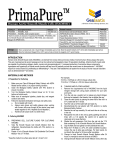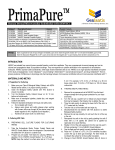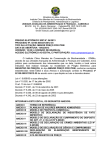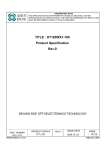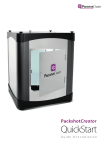Download Rat Marrow Stromal Cells (RMSC)
Transcript
Rat Marrow Stromal Cells (RMSC) Catalog # Description/Content Amount SR49205 Cryopreserved RMSC >500,000 cells SR49205K RMSC Complete System 1 Kit* *Each kit contains an ampoule of cryopreserved RMSC (SR49205), 500 ml of Rat Marrow Stromal Cell Growth Medium (SMR419500), and a Subculture Reagent Kit (PR090100K). Storage: A division of Gene Therapy Systems, Inc. Related Products Rat Marrow Stromal Cell Growth Medium, 500 ml Subculture Reagent Kit, including100 ml each of HBSS, Trpsin/EDTA, and Trpsin Neutralizing Solution Rat Osteoblast Differentiation Medium Adipocyte Differentiation Medium Catalog # SMR419500 PR090100K SR417D250 SR811D250 Store cryopreserved vials in liquid nitrogen immediately upon arrival. Store the growth medium at 4°C in the dark immediately upon arrival. Store the Subculture Reagent Kit at -20°C upon arrival and store the reagents at 4°C upon thawing. INTRODUCTION Rat Marrow Stromal Cells (RMSC) are isolated from rat bone marrow and are cryopreserved at second passage. RMSC can be cultured and propagated 10 population doublings. In addition to supporting hematopoietic cells1, marrow stromal cells can be induced to differentiate and express the traits of multiple cell lineages, including connective tissue (such as bone, cartilage, and fat)2,3,4,5 and neural cells6,7. The multipotent potential of RMSC in vitro provides new avenues for cell-based therapy, and studies have demonstrated the use of 3-D scaffolds for tissue engineering using RMSC8,9. MATERIALS AND METHODS I. Preparation for Culturing B. 1. 1. 2. 2. 3. 4. 5. Make sure your Class II Biological Safety Cabinet, with HEPA filtered laminar airflow, is in proper working condition. Clean the Biological Safety Cabinet with 70% alcohol to ensure it is sterile. Turn the Biological Safety Cabinet blower on for 10 min. before cell culture work. Make sure all serological pipettes, pipette tips, and reagent solutions are sterile. Follow the standard sterilization technique and safety rules: a. Do not pipette with mouth. b. Always wear gloves and safety glasses when working with human cells even though all the strains have been tested negative for HIV, Hepatitis B and Hepatitis C. c. Handle all cell culture work in a sterile hood. II. Culturing RMSC A. 1. 2. PREPARING CELL CULTURE FLASKS Take the Rat Marrow Stromal Cell Growth Medium from the refrigerator. Decontaminate the bottle with 70% alcohol in a sterile hood. Pipette 15 ml of Rat Marrow Stromal Cell Growth Medium* into a T-75 flask. * Keep the medium to surface area ratio at 1 ml per 5 cm2. For example, 5 ml for a T-25 flask or a 60 mm tissue culture dish. 15 ml for a T-75 flask or a 100 mm tissue culture dish. 3. 4. 5. 6. 7. 8. 9. 10. 11. 12. 13. 14. THAWING AND PLATING RMSC Remove the cryopreserved vial of RMSC from the liquid nitrogen storage tank using proper protection. Turn the vial cap a quarter turn to release any liquid nitrogen that may be trapped in the threads, then re-tighten the cap. Thaw the cells quickly by placing the lower half of the vial in a 37°C water bath for 1 minute. Take the vial out of the water bath and wipe dry. Decontaminate the vial exterior with 70% alcohol in a sterile Biological Safety Cabinet. Remove the vial cap carefully. Do not touch the rim of the cap or the vial. Resuspend the cells in the vial by gently pipetting the cells 5 times with a 2 ml pipette. Be careful not to pipette too vigorously as to cause foaming. Pipette the cell suspension (1ml) from the vial into the T-75 flask containing 15 ml of Rat Marrow Stromal Cell Growth Medium. Cap the flask and rock gently to evenly distribute the cells. Place the T-75 flask in a 37oC, 5% CO2 humidified incubator. Loosen the cap to allow gas exchange. For best results, do not disturb the culture for 24 hours after inoculation. Change to fresh Rat Marrow Stromal Cell Growth Medium after 24 hours or overnight to remove all traces of DMSO. Change Rat Marrow Stromal Cell Growth Medium every other day until the cells reach 60% confluent. Double the Rat Marrow Stromal Cell Growth Medium volume when the culture is >60% confluent or for weekend feedings. Subculture the cells when the RMSC culture reaches 85-95% confluent. Rat Mesenchymal Stem Cells (RMSC) Manual III. Subculturing RMSC A. 1. 2. 3. 4. B. 1. 2. PREPARING SUBCULTURE REAGENTS Remove the Subculture Reagent Kit from the -20°C freezer and thaw overnight in a refrigerator. Make sure all the subculture reagents are thawed. Swirl each bottle gently several times to form homogeneous solutions. Store all the subculture reagents at 4°C for future use. The activity of Trypsin/EDTA Solution will be stable for 2 weeks when stored at 4°C. Aliquot Trypsin/EDTA solution and store the unused portion at -20°C if only portion of the Trypsin/EDTA is needed. PREPARING CULTURE FLASK Take the Rat Marrow Stromal Cell Growth Medium from the refrigerator. Decontaminate the bottle with 70% alcohol in a sterile hood. Pipette 35 ml of Rat Marrow Stromal Cell Growth Medium to a T-175 flask (to be used in Section III C Step 15). 10. Examine the T-75 flask under a microscope. If there are >20% cells left in the flask, repeat Steps 2-9. 11. Centrifuge the conical tube at 220 x g for 5 minutes to pellet the cells. 12. Aspirate the supernatant from the tube without disturbing the cell pellet. 13. Flick the tip of the conical tube with your finger to loosen the cell pellet. 14. Resuspend the cells in 5 ml of Rat Marrow Stromal Cell Growth Medium by gently pipetting the cells to break up the clumps. 15. Count the cells with a hemocytometer or cell counter. Inoculate at 10,000 cells per cm2 for rapid growth, or at 5,000 cells per cm2 for regular subculturing. IV. Differentiating RMSC A. SEEDING RMSC FOR DIFFERENTIATING INTO OSTEOBLASTS 1. Seed RMSC in the desired format at 10,000 per cm2. 2. Place the cells 37oC, 5% CO2 humidified incubator. 3. Change to Rat Osteoblast Differentiation Medium (sold separately) the next day by removing the growth medium from culture tissue ware by aspiration and adding the appropriate volume of Rat Osteoblast Differentiation Medium. Do not allow cells to dry during medium changes. 4. Incubate cell in a 37oC, 5% CO2 humidified incubator. 5. Change to fresh Rat Osteoblast Differentiation Medium every three (3) days. 6. Extracellular matrix will be mineralized in 30 days. C. SUBCULTURING RMSC Trypsinize Cells at Room Temperature. Do Not Warm Any Reagents to 37°C. 1. Remove the medium from culture flasks by aspiration. 2. Wash the monolayer of cells with HBSS and remove the solution by aspiration. 3. Pipette 5 ml of Trypsin/EDTA Solution into the T-75 flask. Rock the flask gently to ensure the solution covers all the cells. 4. Remove 4 ml of the solution immediately. 5. Re-cap the flask tightly and monitor the trypsinization progress at room temperature under an inverted microscope. It usually takes about 2 to 5 minutes for the cells to become rounded. The cells may not be completely round during trypsinization and some cells may maintain some processes even though they are loosened from the culture surface. 6. Release the rounded cells from the culture surface by hitting the side of the flask against your palm until most of the cells are detached. 7. Pipette 5 ml of Trypsin Neutralizing Solution to the flask to inhibit further tryptic activity. 8. Transfer the cell suspension from the flask to a 50 ml sterile conical tube. 9. Rinse the flask with an additional 5 ml of Trypsin Neutralizing Solution and transfer the solution into the same conical tube. 1. 2. REFERENCES LICENSE: 1. 2. 3. 4. 5. 6. 7. 8. 9. Purchasers may refuse this license by returning the enclosed materials unused. By keeping or using the enclosed materials, you agree to be bound by the terms of this license. The laws of the State of California shall govern the interpretation and enforcement of the terms of this license. Rochefort, GY et al., (2006) Stem Cells 24(10):2202. Yeon Lim, J et al., (2006) Exp Neurol. 199(2):416. Sergeeva, NS et al., (2006) Bull Exp Biol Med. 141(4): 530. Backesjo, CM et al., (2006) J Bone Miner Res. 21(7): 993. Want, Q et al., (2006) Biochem Biophys Res Commun. 347(1):117. Yang, LY et al., (2006) Biomed Environ Sci. 19(5):329. Tohill, M et al., (2004) Neurosci Lett. 362(3): 200. Li, M et al., (2005) Conf Proc IEEE Eng Med Biol Soc 6(1):5858. Claase, MB et al., (2007) J Mater Sci Mater Med.. B. SEEDING RMSC FOR DIFFERENTIATING INTO ADIPOCYTES 3. 4. 5. 6. Seed the RMSC at 40,000 cells/cm2 in the desired format. Place the cells in a 37°C, 5% CO2 humidified incubator. Change to Adipocyte Differentiation Medium (sold separately) after three days by removing growth medium from culture tissue ware by aspiration and adding the appropriate volume of Adipocyte Differentiation Medium. Do not allow cells to dry during medium changes. Incubate cell in a 37oC, 5% CO2 humidified incubator. Change to fresh Adipocyte Differentiation Medium every three (3) days. Cells are differentiated into adipocytes with large lipid droplets in 3-4 weeks. The purchase price paid for the PrimaPure™ cells and reagents grants end users a nontransferable, non-exclusive license to use the kit and/or its components for internal research use only as described in this manual; in particular, research use only excludes and without limitation, resale, repackaging, or use for the making or selling of any commercial product or service without the written approval of Genlantis. Separate licenses are available for non-research use or applications. The PrimaPure™ cells and reagents are not to be used for human diagnostic or included/used in any drug intended for human use. Care and attention should be exercised in handling the product by following appropriate research lab practices. Genlantis Page 2 of 2 10190 Telesis Court. San Diego, CA 92121 • Toll Free (888) 428-0558 • U.S. & Canada (858) 457-1919 • www.genlantis.com MV10112007 2006 Gelantis and Gene Therapy Sytems, Inc.


